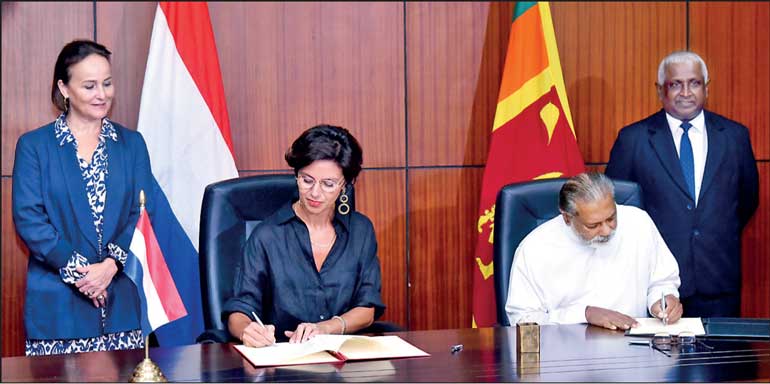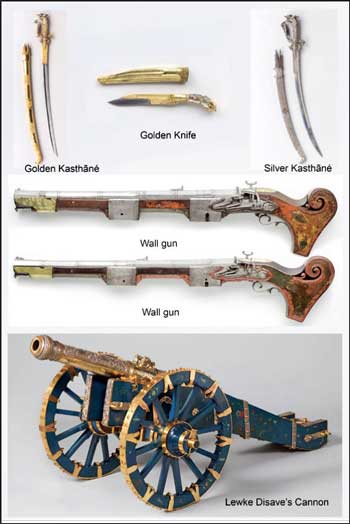Saturday Apr 19, 2025
Saturday Apr 19, 2025
Wednesday, 30 August 2023 00:30 - - {{hitsCtrl.values.hits}}

Signing of ‘Transfer of Acknowledgment’ by Netherlands Culture and Media State Secretary Gunay Sulu and Buddhasasana, Religious and Cultural Affairs Minister Vidura Wickramanayake – Pix by Ruwan Walpola

Exchange of ‘Loan Agreement ‘by Netherlands Culture and Media State Secretary Gunay Sulu and Department of National Museums of Sri Lanka Director General Sanuja Kasthuriarachchi
 In a collaborative international provenance research which was concluded in April 2022, six Sri Lankan objects from the Rijksmuseum collection in the Netherlands were confirmed to be of Lankan origin.
In a collaborative international provenance research which was concluded in April 2022, six Sri Lankan objects from the Rijksmuseum collection in the Netherlands were confirmed to be of Lankan origin.
A golden and a silver kasthãné or sabre, a golden knife, two maha thuwakku or wall guns and Lewke Disave’s cannon – all belonging to the Kandyan kingdom, now found in the Rijksmuseum collection were confirmed to be war booty, obtained by the Dutch East India Company (VOC) during the siege of the palace of Kandy in 1765 when large scale looting of Kandyan objects took place.
Following the conclusion of the provenance study, a diplomatic request was made by Buddhasasana, Religious and Cultural Affairs Minister Vidura Wickremanayake to the Dutch Ministry of Education, Culture and Science to return the six objects to Sri Lanka.
It is significant that this was the first request which was taken up before the independent commission appointed by the Government of the Kingdom of the Netherlands to assess and facilitate the return of colonial objects to their respective countries of origin.
On the recommendations made by the committee, the six objects will be officially returned to Sri Lanka. The decision was gazetted in the Netherlands on 6 July. The Sri Lankan Advisory Committee on the Return of Artefacts has been appointed by the Cabinet to facilitate the return of the six objects.
Commenting on the occasion, Department of National Museums Director General Sanuja Kasthuriarachchi noted that the whole exercise is a historical moment from many perspectives. “The laborious provenance research has led to the dispelling of many myths and ambiguities that shrouded our Kandyan artefacts for centuries. It is heartening to see these cultural symbols which mirror the cleverness of Sri Lankan artisans of yesteryear, reclaiming their due pride of place in their land of birth.”
The joint research that was carried out under the Pilot Project Provenance Research on Objects of the Colonial Era (PPROCE) of the Rijksmuseum is also a landmark in Sri Lankan provenance studies. Since the Provenance Report of the National Museum in Colombo Director Dr. P.H.D.H. de Silva, in the 1970s, very little notice was taken of the Kandyan objects in discussion until this recent intense study. The international joint provenance research represented researchers from Sri Lanka and the Netherlands. The local research team comprised the Department of National Museums Additional Director General (Cultural), Senarath Wickramasinghe, Prof. Asoka de Zoysa and Dr. Ganga Dissanayake from the University of Kelaniya and firearms specialist and the author of several books on the Kandyan period, Chamikara Pilapitiya. The Department of National Archives also made a significant contribution to the research by providing numerous archival materials.
Scores of historical documents, Dutch records, art and craftsmanship of objects in the study, their artistic value, technology and chemical composition were among the criteria adopted by the experts in determining the provenance of the Kandyan objects. The golden and silver kasthãnés presented in the Rijksmuseum as spoils of war were obtained by the VOC during the siege of the palace of Kandy in 1765 when large-scale looting of Kandyan objects took place. The research confirms that both kasthanes were made in the royal workshop and were probably meant for a Kandyan aristocrat.
The intricately crafted knife which also reflects the skill of the 18th-century Kandyan workmanship, formed part of the royal garb.
The two wall guns which translated into maha thuwakku in the vernacular during the Kandyan times are decorated with woodwork and engraved symbols. The guns represent a unique and early Sri Lankan tradition in gun-making and warfare.
The two wall guns, each weighing 28kg, are unique examples of mobile, heavy artillery that the troops of the Kandyan king used to defend the city and the palace.
Richly ornamented with silver, gold and gemstones, Lewke Disave’s cannon is another interesting object among the six artefacts. Embellished with Kandyan designs such as liyawel, kalpa vrukshaya and nari lata, the cannon bears an inscription which claims the Kandyan aristocrat Leweke Disave to be the donor of the cannon.
Once the transfer of ownership is acknowledged upon signing of relevant documents, the exact date of arrival of the six artefacts on the island will be determined. Upon the arrival of these historical objects, a public exhibition featuring them is to be organised by the Department of National Museums. “Although the backdrop in which these historical artefacts of ours were taken to the Netherlands was that of grief and pain, we earnestly hope that their journey of returning home more than two centuries later will be that of delight. This journey will further strengthen the diplomatic relations between the Netherlands and Sri Lanka,” says the Department of National Museums DG who extends her sincere thanks to the Minister Vidura Wikramanayake, Secretary to the Ministry of Buddhasasana, Religious and Cultural Affairs Somarathna Vidanapathirana and Ambassador of the Netherlands to Sri Lanka, Bonnie Horbach for their unfailing support and enthusiasm in this exercise.
Cultural cooperation between Dutch and Sri Lankan institutions has already commenced and will focus on the exchange of technical expertise, knowledge sharing and education. It is hoped that this cooperation will lead to more returns of the Sri Lankan artefacts in the future. The recently established Sri Lankan Advisory Committee on the Return of Artefacts will take the lead in the cooperation as well as requests for the return of the artefacts to their country of origin.
Discover Kapruka, the leading online shopping platform in Sri Lanka, where you can conveniently send Gifts and Flowers to your loved ones for any event including Valentine ’s Day. Explore a wide range of popular Shopping Categories on Kapruka, including Toys, Groceries, Electronics, Birthday Cakes, Fruits, Chocolates, Flower Bouquets, Clothing, Watches, Lingerie, Gift Sets and Jewellery. Also if you’re interested in selling with Kapruka, Partner Central by Kapruka is the best solution to start with. Moreover, through Kapruka Global Shop, you can also enjoy the convenience of purchasing products from renowned platforms like Amazon and eBay and have them delivered to Sri Lanka.
Discover Kapruka, the leading online shopping platform in Sri Lanka, where you can conveniently send Gifts and Flowers to your loved ones for any event including Valentine ’s Day. Explore a wide range of popular Shopping Categories on Kapruka, including Toys, Groceries, Electronics, Birthday Cakes, Fruits, Chocolates, Flower Bouquets, Clothing, Watches, Lingerie, Gift Sets and Jewellery. Also if you’re interested in selling with Kapruka, Partner Central by Kapruka is the best solution to start with. Moreover, through Kapruka Global Shop, you can also enjoy the convenience of purchasing products from renowned platforms like Amazon and eBay and have them delivered to Sri Lanka.